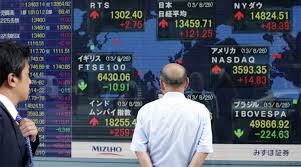Asian stocks staged a recovery on Tuesday, rebounding from 18-month lows as markets caught their breath following a period of intense selling.
Optimism surrounding potential trade negotiations with the US helped to lift sentiment, with US stock futures also pointing higher.
US Treasury yields continued their ascent from six-month lows, while gold prices stabilized near a 2 1/2-week low, and crude oil prices recovered from near four-year lows, as traders cautiously shifted back towards riskier assets from traditional safe havens.
Japan’s Nikkei index led the regional rally, surging 5.6%, significantly outpacing other markets.
This surge comes as Treasury Secretary Scott Bessent and Trade Representative Jamieson Greer have been tasked with leading trade negotiations with Tokyo, fueling hopes for a potential breakthrough.
US business leaders have also begun speaking out about the potential damage to the economy and financial markets that could result from President Donald Trump’s global trade war.
JPMorgan Chase CEO Jamie Dimon, for example, warned on Monday about the risks of inflation and a US economic slowdown.
Trump digs in: vows more tariffs against China
Despite these concerns, Trump has doubled down on his hard-line stance with China, vowing to impose additional 50% levies if Beijing does not withdraw its retaliatory tariffs on the United States.
Beijing responded on Tuesday, stating that it will never accept the “blackmail nature” of US tariff threats, setting the stage for continued trade tensions.
Even so, Hong Kong’s Hang Seng index climbed 1.7% in early trading, while mainland Chinese blue chips added 0.6%, reflecting a degree of resilience in the face of the ongoing trade dispute.
However, the Chinese yuan weakened to 7.36 per dollar in the offshore market, hitting a two-month low.
“Importantly, a little ray of sunshine is starting to emerge that gives hope that the US is genuinely open to trade negotiations, … the most significant being Japan with Treasury Secretary Bessent,” Business Insider report quoted Tapas Strickland, head of market economics at National Australia Bank,
Strickland cautioned, however, that volatility remains extremely elevated, with the “rare event” of the VIX index spiking as high as 60 overnight, highlighting the fragility of market sentiment.
South Korea’s KOSPI added 1.3%, and Australia’s equity benchmark gained 1%, further contributing to the regional rebound.
Taiwan’s equity benchmark, however, sank 3%, following its worst day ever on Monday, when it tumbled 10%.
The major semiconductor producer faces a 32% duty from Washington, raising concerns about its future prospects.
European and US markets eye gains: futures point higher
Pan-European STOXX 50 futures rallied 2.2%, suggesting a positive open for European markets.
U.S. S&P 500 futures rose 0.9%, after the cash index ended a wild session with a 0.2% loss on Monday, highlighting the volatility that has gripped Wall Street.
The market’s whipsawing behavior reflects the conflicting forces at play, as investor sentiment oscillates between optimism about potential trade resolutions and anxiety about Trump’s unpredictable policies.
Wall Street swung between heavy losses and gains throughout the session as investors were whipsawed by tariff headlines.
A media report claiming Trump was considering a 90-day pause in duties for all countries except China briefly turned US stocks positive early in the session, but it was quickly dismissed by the White House as “fake news,” sending the market back into negative territory.
“The signs are there that if the market hears what it wants to hear then risky assets could explode higher,” said Chris Weston, head of research at Pepperstone.
However, Weston cautioned against excessive optimism, arguing that “what played out was more in fitting with a bear market rally and one that traders should look to fade, rather than believing we’ve reached a key inflection point for a sustained trend higher.”
The 10-year Treasury yield rose as much as 6 basis points (bps) to 4.216% on Tuesday, after jumping some 17 bps on Monday as it bounced from six-month lows, reflecting a move away from safe-haven assets.
This upward movement in yields also helped to lift Japanese government bond yields off their own multi-month lows, with the 10-year yield up 12.5 bps to 1.235%.
The US dollar edged lower against a basket of six major peers, but that followed a two-day 1.2% advance from a six-month trough.
The dollar eased 0.06% to 147.70 yen. The euro jumped 0.4% to $1.0944, and sterling climbed 0.3% to $1.2762.
EU seeks a deal: offers ‘zero-for-zero’ tariff plan
The European Commission said on Monday that it had offered a “zero-for-zero” tariff deal to avert a trade war with the United States, as EU ministers agreed to prioritize negotiations while also striking back with 25% tariffs on some US imports, signaling a willingness to defend its interests.
The risk-sensitive Australian dollar added 0.2% to $0.6001.
Gold prices were steady at around $2,985 per ounce, but well back from last Thursday’s record peak at $3,167.57, reached in the immediate aftermath of Trump’s “Liberation Day” tariff announcement.
Crude oil strongly rebounded after it fell to nearly four-year lows on Monday.
Brent futures were up 1.26% at $65.02 per barrel, while US West Texas Intermediate crude futures rose 1.52% to $61.61.
The post Trade talk hopes lift Asian stocks, but Trump’s China stance looms appeared first on Invezz

